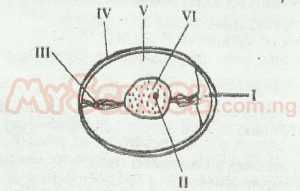Year :
2010
Title :
Biology
Exam :
WASSCE/WAEC MAY/JUNE
Paper 1 | Objectives
21 - 30 of 60 Questions
| # | Question | Ans |
|---|---|---|
| 21. |
 The part labelled III is the A. albumen B. chalaza C. yolk D. air space |
B |
| 22. |
Which of the following statements ls true about transpiration? It is the A. loss of water in the form of vapour from the surface of the’ leaf B. loss of water in the form of vapour from the surface of the root C. absorption of water in the form of vapour from the body of the pint D. movement of water through the body of the plant. |
A |
| 23. |
Transportation of water in the xylem tissue involves the following except A. root pressure B. capillary action C. transpiration pull D. translocation |
D |
| 24. |
The following are the major reasons why the butterfly lays eggs under the surface of a leaf except to A. shade the eggs from the direct rays of the sun. B. protect the eggs from predators C. protect the eggs from being washed away by rain drops D. camouflage the eggs |
D |
| 25. |
In which of the following organic compounds is the hydrogen-oxygen ratio equal to 2:1? A. Proteins B. Carbohydrates C. Lipids D. Vitamins |
B |
| 26. |
A man suffering from obesity must avoid meals containing A. margarine and butter B. rice and beans C. carrots and oranges D. beef and fish |
A |
| 27. |
In testing for starch in a leaf, the leaf is first boiled in water for about a minute so that the A. cell walls are hardened B. cells are killed C. chlorophyll is dissolved out D. iodine will penetrate |
B |
| 28. |
Which of the following food substances is incorrectly linked to its enzyme? A. Protein - trypsin B. Fat - lipase C. Sucrose - pepsin D. Starch - amylase Detailed SolutionAll the enzymes are rightly matched to the class of food they act upon except the Sucrose - Pepsin match. Pepsin acts upon proteins and not sucrose essentially. |
|
| 29. |
Which of the following pH values is the best for the action of the enzymes - renin and pepsin in the A. pH2 B. pH7 C. pH8 D. pH9 |
A |
| 30. |
The bacterium in a mutualistic association with legumes converts A. nitrates to ammonia B. ammonium compounds to nitrites C. nitrogen gas to ammonia D. nitrites to nitrates |
D |
| 21. |
 The part labelled III is the A. albumen B. chalaza C. yolk D. air space |
B |
| 22. |
Which of the following statements ls true about transpiration? It is the A. loss of water in the form of vapour from the surface of the’ leaf B. loss of water in the form of vapour from the surface of the root C. absorption of water in the form of vapour from the body of the pint D. movement of water through the body of the plant. |
A |
| 23. |
Transportation of water in the xylem tissue involves the following except A. root pressure B. capillary action C. transpiration pull D. translocation |
D |
| 24. |
The following are the major reasons why the butterfly lays eggs under the surface of a leaf except to A. shade the eggs from the direct rays of the sun. B. protect the eggs from predators C. protect the eggs from being washed away by rain drops D. camouflage the eggs |
D |
| 25. |
In which of the following organic compounds is the hydrogen-oxygen ratio equal to 2:1? A. Proteins B. Carbohydrates C. Lipids D. Vitamins |
B |
| 26. |
A man suffering from obesity must avoid meals containing A. margarine and butter B. rice and beans C. carrots and oranges D. beef and fish |
A |
| 27. |
In testing for starch in a leaf, the leaf is first boiled in water for about a minute so that the A. cell walls are hardened B. cells are killed C. chlorophyll is dissolved out D. iodine will penetrate |
B |
| 28. |
Which of the following food substances is incorrectly linked to its enzyme? A. Protein - trypsin B. Fat - lipase C. Sucrose - pepsin D. Starch - amylase Detailed SolutionAll the enzymes are rightly matched to the class of food they act upon except the Sucrose - Pepsin match. Pepsin acts upon proteins and not sucrose essentially. |
|
| 29. |
Which of the following pH values is the best for the action of the enzymes - renin and pepsin in the A. pH2 B. pH7 C. pH8 D. pH9 |
A |
| 30. |
The bacterium in a mutualistic association with legumes converts A. nitrates to ammonia B. ammonium compounds to nitrites C. nitrogen gas to ammonia D. nitrites to nitrates |
D |